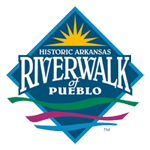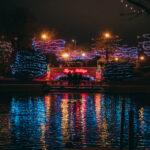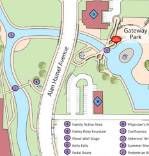Every place has a story, and the Pueblo Riverwalk is no exception. This beautiful waterway lies in the heart of Pueblo, Colorado, offering a unique blend of history, art, nature, and community to the downtown area. From boat rides and events to riverside dining and local art installations, the Riverwalk is a must-visit attraction for those looking to experience the charm and vibrancy of Pueblo.
A scenic and cultural destination that’s a focal point of the community, the Riverwalk is more than just a tourist destination. It holds deep significance for the city, serving as a community centerpiece, reflecting the resilience and spirit of Pueblo while commemorating the 1921 flood that reshaped the region. Its transformation from a flood control project to a thriving urban park is a testament to the city’s commitment to revitalization.
Whether you’re a history buff, nature lover, art enthusiast, or simply looking for a delicious meal and a good beer or cocktail in the heart of the city, the Pueblo Riverwalk offers something for everyone. From its town-shaping history to its ongoing transformation, it plays a pivotal role in the cultural life of Pueblo and is a true gem in Colorado’s landscape.
The Arkansas River and the Devastating Flood of 1921: The History of Riverwalk
The Arkansas River flows through the heart of this region in southern Colorado and played an important role in its history. It was a water and food source for Native Americans, playing a central role in the early settlement and development of Pueblo, providing a vital water source and serving as a natural transportation route.
In the 1800s, Pueblo emerged as an important hub along the river, which acted as a lifeline for early pioneers, traders, and settlers. The river’s strategic location attracted various industries, including steel production, agriculture, and trade, and helped establish Pueblo as a prominent industrial center in the West. The proximity to the river was critical, as it facilitated transportation and provided water for factories, railroads, and farmlands, further fueling Pueblo’s economic rise.
The prosperity turned to disaster for the small town on June 3, 1921, when a catastrophic flood devastated Pueblo, forever changing it. The Arkansas River, swollen from heavy rains and snow melt, breached its banks, overcame its levees, and engulfed the downtown area, destroying buildings, businesses, rail lines, and homes. With surges of nearly 14 feet in some places, the flood claimed over 500 lives, wiped out livestock, and caused millions of dollars in damage. This disaster exposed the city’s vulnerability to the river’s natural force and led to rebuilding and recovery efforts focused on preventing future tragedies. In the aftermath of the 1921 flood, Pueblo undertook one of its most ambitious and transformative projects: diverting the river away from the center of the town. Engineers redirected the Arkansas River south of downtown, dramatically altering its course and laying the groundwork for a safer and more resilient urban environment. While this decision protected Pueblo from future floods, it also meant that the once vibrant riverfront became disconnected from the city’s heart, impacting commerce and community life.
The flood and subsequent diversion of the Arkansas River had a lasting impact on the city’s future development. In the decades that followed, Pueblo sought ways to reconnect the community with the river that had once defined its landscape. The idea of revitalizing the riverfront would eventually lead to the creation of the Pueblo Riverwalk, a project aimed at urban renewal, economic revitalization, and preserving the river’s historical significance.
From Idea to Reality: The Vision for Riverwalk
The vision for the Pueblo Riverwalk began as a bold idea in the late 20th century. After the 1921 flood, the Arkansas River lost much of its former significance in the city. Driven by a desire to revitalize the downtown area and reconnect the city with the history and relevance of the waterway, the plans for the Riverwalk began to take shape. Inspired by other successful urban waterways, including San Antonio’s famous River Walk, civic leaders saw an opportunity to breathe new life into the area by creating Pueblo’s own scenic waterfront that would serve as a destination, a community gathering space, and a place for local businesses to set up shop. In the early 1990s, civic leaders, including city officials and community advocates, recognized that such a project could provide economic benefits, attract tourists, and foster a sense of community pride. This ambitious idea led to the creation of HARP, the Historic Arkansas Riverwalk of Pueblo project in 1993, a decades-long endeavor that reshaped the city’s identity by creating the centerpiece of a larger urban renewal plan.
The Riverwalk’s construction unfolded over several phases, with the first portion opening in 2000. Over the next two decades, the project continued to expand, with an additional $16 million allocated for new phases, including the fourth and final expansion with completion expected in 2026.
Blending the area’s historical significance with modern facilities and beautiful landscaping, the Riverwalk is a space where the community can reconnect with the river that was once the lifeblood of Pueblo while enjoying dining, shopping, and entertainment. It’s a testament to the vision and dedication to restoring the river to the heart of the city by creating a community-focused waterfront that celebrates Pueblo’s past while looking toward its future.
From Industrial Ruins to Cultural Gem: The Transformation of the Pueblo Riverwalk
After the flood, the part of Pueblo that was once the heart of the town gradually became an area of industrial and underutilized spaces. The Riverwalk represents a transformation to a new vision of the old heart of downtown Pueblo. Instead of the Arkansas River and what it offered early settlers, the Riverwalk now sits in its place and serves as a vibrant public space and the centerpiece of downtown Pueblo. Over the years, the Riverwalk has expanded through multiple phases, each contributing to its integration into the community’s social, cultural, and economic life.
Significant features along the Riverwalk include scenic walking paths that encourage walking and jogging, boating activities that offer a new way to experience the water, and striking public art installations that celebrate local artists and history. The blend of recreational, artistic, and historical elements creates a dynamic space where community life and history coexist.
A destination for both locals and tourists, the Riverwalk plays a crucial role in Pueblo’s economic revitalization, acting as a bridge between the past and the present, reflecting the city’s history, culture, and vision for the future. Boat tours, waterfront dining, unique shops, and community events throughout the year make the area the center of activity and creates a ripple effect, encouraging further development in the surrounding areas and contributing to the downtown economy.
Revitalizing Community and Commerce: The Riverwalk and the Economy
Economically, the Riverwalk has been a catalyst for revitalization in downtown Pueblo. It attracts tourists and locals alike, providing a significant boost to the local economy. Visitors enjoy the unique experience of dining at riverside restaurants, shopping at local boutiques, and participating in outdoor activities like boating and walking along the scenic pathways. This influx of visitors encourages the development of new businesses and supports the growth of existing ones, with local entrepreneurs benefiting from the increased foot traffic. Many business owners in the area credit the Riverwalk for bringing new life to the downtown area.
The Riverwalk also fosters a deep sense of community pride among Pueblo’s residents. It has become a symbol of the city’s resilience, commemorating the 1921 flood while showcasing the efforts to rebuild and thrive. City officials often speak of the Riverwalk as a cornerstone of Pueblo’s urban renewal, with its ongoing expansion and development reflecting the city’s commitment to preserving its history while promoting economic growth. Residents, too, have embraced the Riverwalk as a treasured space where they can connect, enjoy recreational activities, attend events, and celebrate Pueblo’s unique identity.
Testimonials from local business owners, residents, and city officials highlight the profound impact the Riverwalk has had on the community. Many describe it as a turning point in Pueblo’s transformation, helping to restore pride in the city while attracting new opportunities for growth.
Expansion and Construction: The Future of the Pueblo Riverwalk
Ongoing development plans ensure the Riverwalk will continue to evolve, with future expansions and improvements aimed at enhancing its appeal as a local and tourist destination. The next step in the expansion project is adding another channel to the waterway that extends toward Santa Fe Avenue. In addition to the new channel, the HARP Expansion Project also includes the construction of a two-story boat house which will increase the opportunities for events and gatherings with its rooftop deck and close access to the Riverwalk Excursion Boats.
Through thoughtful expansion, a commitment to sustainability, and continued integration of art, culture, and nature, the future of the Pueblo Riverwalk promises to be as vibrant and impactful as its past. It will continue to serve as a popular destination, allowing residents and tourists to spend time outside or inside, at events, dining, shopping, boat rides, and more.
Events, Boat Rides, and More: Discover the Riverwalk
While other river walks in the U.S. like San Antonio’s or Chicago’s may be more well-known, Pueblo’s Riverwalk stands out for its intimate connection to local history and culture. Visitors can enjoy boat rides, stroll along beautifully landscaped walkways, and explore the community areas, all while immersed in a space that beautifully balances urban design with the tranquility of nature.
There are plenty of options for a perfect day at Riverwalk, including:
- Dining at one of the unique Riverwalk restaurants along and near the river, from brewpubs to pizza and sushi to steak.
- Shopping and a little self-care are always a good combination, and you can find both at Pueblo Riverwalk.
- Take a walk along the landscaped paths early in the morning, during lunch hour, late in the afternoon, after dinner, with your dog – anytime is a good time for a Riverwalk walk.
- Do not miss the stunning works in the Riverwalk art collection. You’ll find more than 60 pieces of sculpture and installations as you stroll the walking paths.
- Boat rides are the star attractions along the Riverwalk, with options to meet everyone’s expectations:
- Try a relaxing narrated historical tour on an excursion boat with a driver.
- If you’re feeling a little more ambitious, hop into one of the duck-shaped pedal boats and scoot around the pedal boat zone on a sunny summer afternoon.
- Grab your board and join the Riverwalk Paddling Club for some fun with like-minded paddlers.
- Visit the Veteran’s Bridge, the only monument in the United States to recognize veterans of all military branches.
- In addition to the daily options, you’ll find Riverwalk events throughout the year, including live music, charity walks and runs, Fright Night trick-or-treating, the holiday lighting extravaganza, and more. Check the calendar to learn what’s happening.
- Are you planning an event? Riverwalk has a water-front venue perfect for weddings, reunions, birthdays, company parties, and more.
- For all you teachers, don’t miss the Pike Curriculum Guide to help your students discover the history of southeastern Colorado.
After experiencing the Riverwalk, visitors should consider exploring other nearby attractions, such as the El Pueblo History Museum, the shops and galleries along Union Avenue, and the Sangre de Cristo Arts Center, all of which add depth to Pueblo’s rich cultural tapestry.
Come for a Visit: Pueblo Riverwalk
The Pueblo Riverwalk is more than just a scenic spot—it’s a vibrant urban area where history, culture, and the community’s spirit come together, inviting you to experience its charm and energy. Over the years, it has transformed from an ambitious idea into a thriving space that captures the spirit of Pueblo. As a cultural, historical, and recreational site, it plays a vital role in the city’s identity, bringing together art, history, nature, and community. From its roots commemorating the 1921 flood to becoming the bustling city center, the Riverwalk continues to grow, reflecting Pueblo’s commitment to revitalization and community connection.
If you haven’t yet experienced the beauty and vibrancy of the Pueblo Riverwalk, now is the perfect time to plan a visit. Experience the bars and restaurants, walk along the peaceful paths, enjoy a boat ride, explore the rich history through public art, attend an event, or simply relax in the scenic surroundings. Whether you’re a resident or a visitor, the Riverwalk offers a unique experience that showcases the heart of Pueblo and all it has to offer.




